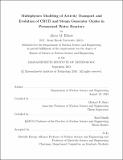| dc.contributor.advisor | Michael P. Short. | en_US |
| dc.contributor.author | Elliott, Alicia M. | en_US |
| dc.contributor.other | Massachusetts Institute of Technology. Department of Nuclear Science and Engineering. | en_US |
| dc.date.accessioned | 2019-10-11T20:20:04Z | |
| dc.date.available | 2019-10-11T20:20:04Z | |
| dc.date.copyright | 2018 | en_US |
| dc.date.issued | 2018 | en_US |
| dc.description | This electronic version was submitted by the student author. The certified thesis is available in the Institute Archives and Special Collections. | en_US |
| dc.description | Thesis: S.M., Massachusetts Institute of Technology, Department of Nuclear Science and Engineering, 2018 | en_US |
| dc.description | Cataloged from student-submitted PDF version of thesis. | en_US |
| dc.description | Includes bibliographical references (pages 121-123). | en_US |
| dc.description.abstract | Fouling deposits of corrosion products on fuel cladding, known as crud, in the core of light water reactors can cause a variety of operational issues. Buildup of radioactive crud and corrosion products on ex-core structures, such as steam generators and piping, can cause increased radiation fields and higher dose exposures for plant workers. To better understand the mechanisms of corrosion product activity transport and evolution in the primary coolant loop, a crud source term and activity transport code that can predict the concentration of active isotopes in a primary loop over time and plant operating parameters was developed, implementing mechanistic models for soluble corrosion product dissolution and precipitation. The code described in this thesis tracks activated isotope deposition throughout the primary loop with spatial and temporal resolution, without the use of empirical rate constants derived from plant measurements, to predict primary loop activity buildup. Developed in C++ using the MOOSE Framework, this code can be easily coupled to other multiphysics codes through the MOOSE MultiApp system. A set of input file generation scripts, written in Python, were developed to calculate thermodynamic parameters for chemical reactions added to the simulation, and easily set up simulation input files in a "user-friendly" format. The open source code described in this work, Ouroboros, is available freely for future improvements and adaptations to implement additional mechanisms and more rigorous models. This code is the first step towards a long term effort to develop an open source, fully mechanistic crud source term model including all mechanisms for activity transport in pressurized water reactors. | en_US |
| dc.description.statementofresponsibility | by Alicia M. Elliott. | en_US |
| dc.format.extent | 169 pages | en_US |
| dc.language.iso | eng | en_US |
| dc.publisher | Massachusetts Institute of Technology | en_US |
| dc.rights | MIT theses are protected by copyright. They may be viewed, downloaded, or printed from this source but further reproduction or distribution in any format is prohibited without written permission. | en_US |
| dc.rights.uri | http://dspace.mit.edu/handle/1721.1/7582 | en_US |
| dc.subject | Nuclear Science and Engineering. | en_US |
| dc.title | Multiphysics modeling of activity transport and evolution of CRUD and steam generator oxides in pressurized water reactors | en_US |
| dc.type | Thesis | en_US |
| dc.description.degree | S.M. | en_US |
| dc.contributor.department | Massachusetts Institute of Technology. Department of Nuclear Science and Engineering | en_US |
| dc.identifier.oclc | 1121184853 | en_US |
| dc.description.collection | S.M. Massachusetts Institute of Technology, Department of Nuclear Science and Engineering | en_US |
| dspace.imported | 2019-10-11T21:37:04Z | en_US |
